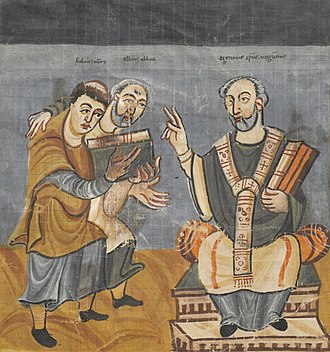Carolingian Renaissance
== Carolingian Renaissance ==
The Carolingian Renaissance was a period of cultural revival and intellectual activity in the Carolingian Empire during the late 8th and 9th centuries, primarily under the reign of Charlemagne and his successors. This era is characterized by a renewed interest in classical scholarship, the arts, and the consolidation of the Christian Church's influence in Western Europe.
Historical Context
The Carolingian Renaissance occurred during the Early Middle Ages, a time often referred to as the Dark Ages due to the perceived cultural and economic decline following the fall of the Western Roman Empire. The Carolingian dynasty, founded by Pepin the Short, sought to revive the cultural and intellectual achievements of the Roman Empire.
Key Figures
- Charlemagne: The most prominent ruler of the Carolingian Empire, Charlemagne was a patron of learning and the arts. He established the Palace School at Aachen, which became a center of scholarly activity.
- Alcuin of York: An English scholar invited by Charlemagne to lead the Palace School. Alcuin played a crucial role in the revival of classical learning and the development of the Carolingian minuscule script.
- Paul the Deacon: A Lombard historian and poet who contributed to the intellectual life of the Carolingian court.
Cultural and Intellectual Achievements
The Carolingian Renaissance saw significant advancements in various fields:
- **Education**: The establishment of monastic and cathedral schools improved literacy and education among the clergy and nobility. The Seven Liberal Arts were emphasized, consisting of the trivium (grammar, rhetoric, and logic) and the quadrivium (arithmetic, geometry, music, and astronomy).
- **Script and Manuscripts**: The development of the Carolingian minuscule script made texts more legible and standardized, facilitating the copying and preservation of classical and Christian works. Illuminated manuscripts, such as the Godescalc Evangelistary, exemplify the artistic achievements of the period.
- **Architecture**: Carolingian architecture blended classical Roman and early Christian styles, leading to the construction of notable buildings such as the Palatine Chapel in Aachen.
- **Art**: Carolingian art included illuminated manuscripts, metalwork, and ivory carvings, often with religious themes. The Lorsch Gospels and the Utrecht Psalter are notable examples.
Religious Reforms
The Carolingian Renaissance also involved significant religious reforms aimed at strengthening the Christian Church and standardizing religious practices. Charlemagne and his advisors sought to correct errors in liturgical texts and improve the moral and educational standards of the clergy.
Legacy
The Carolingian Renaissance laid the groundwork for the later Medieval Renaissance and the Renaissance of the 12th century. It preserved and transmitted classical knowledge, which would later influence the Italian Renaissance and the broader intellectual revival of Europe.
Related Pages
- Charlemagne
- Carolingian Empire
- Carolingian minuscule
- Palatine Chapel
- Alcuin of York
- Early Middle Ages
- Seven Liberal Arts
| Divisions of the Carolingian Empire |
|---|
|
|
Transform your life with W8MD's budget GLP-1 injections from $125.
W8MD offers a medical weight loss program to lose weight in Philadelphia. Our physician-supervised medical weight loss provides:
- Most insurances accepted or discounted self-pay rates. We will obtain insurance prior authorizations if needed.
- Generic GLP1 weight loss injections from $125 for the starting dose.
- Also offer prescription weight loss medications including Phentermine, Qsymia, Diethylpropion, Contrave etc.
NYC weight loss doctor appointments
Start your NYC weight loss journey today at our NYC medical weight loss and Philadelphia medical weight loss clinics.
- Call 718-946-5500 to lose weight in NYC or for medical weight loss in Philadelphia 215-676-2334.
- Tags:NYC medical weight loss, Philadelphia lose weight Zepbound NYC, Budget GLP1 weight loss injections, Wegovy Philadelphia, Wegovy NYC, Philadelphia medical weight loss, Brookly weight loss and Wegovy NYC
|
WikiMD's Wellness Encyclopedia |
| Let Food Be Thy Medicine Medicine Thy Food - Hippocrates |
Medical Disclaimer: WikiMD is not a substitute for professional medical advice. The information on WikiMD is provided as an information resource only, may be incorrect, outdated or misleading, and is not to be used or relied on for any diagnostic or treatment purposes. Please consult your health care provider before making any healthcare decisions or for guidance about a specific medical condition. WikiMD expressly disclaims responsibility, and shall have no liability, for any damages, loss, injury, or liability whatsoever suffered as a result of your reliance on the information contained in this site. By visiting this site you agree to the foregoing terms and conditions, which may from time to time be changed or supplemented by WikiMD. If you do not agree to the foregoing terms and conditions, you should not enter or use this site. See full disclaimer.
Credits:Most images are courtesy of Wikimedia commons, and templates, categories Wikipedia, licensed under CC BY SA or similar.
Translate this page: - East Asian
中文,
日本,
한국어,
South Asian
हिन्दी,
தமிழ்,
తెలుగు,
Urdu,
ಕನ್ನಡ,
Southeast Asian
Indonesian,
Vietnamese,
Thai,
မြန်မာဘာသာ,
বাংলা
European
español,
Deutsch,
français,
Greek,
português do Brasil,
polski,
română,
русский,
Nederlands,
norsk,
svenska,
suomi,
Italian
Middle Eastern & African
عربى,
Turkish,
Persian,
Hebrew,
Afrikaans,
isiZulu,
Kiswahili,
Other
Bulgarian,
Hungarian,
Czech,
Swedish,
മലയാളം,
मराठी,
ਪੰਜਾਬੀ,
ગુજરાતી,
Portuguese,
Ukrainian
Contributors: Prab R. Tumpati, MD






